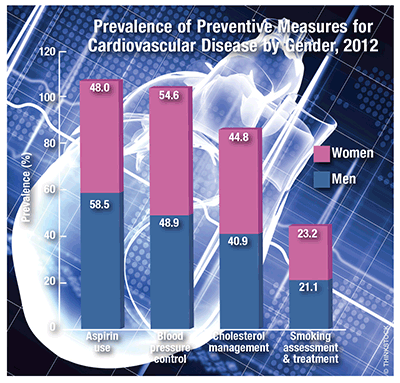US Pharm. 2015;40(2):38
Annually, 1.5 million Americans (500,000 women) will have a heart attack or stroke, according to the CDC. Women aged <50 years are twice as likely as men (47% vs. 24%) to have a fatal heart attack. The lifetime risk of stroke—the fourth leading cause of death—is higher in women because they tend to live longer than men. Evidence-based strategies, including the CDC’s Million Hearts initiative, are being used to reduce the risk of cardiovascular disease.

Aspirin Therapy: The prevalence of aspirin therapy rose from 43.4% in 2005 to 53.8% in 2012, with 22% more men than women using aspirin (58.5% vs. 48.0%). Aspirin therapy was highest (58.9%) among persons aged 65 to 74 years, followed by those aged 45 to 64 years (54.1%) and >75 years (51.4%); persons aged 18 to 44 years had the lowest use (38.5%). Non-Hispanic whites (55.7%) were more likely than non-Hispanic blacks (50.4%) and Hispanics (43.6%) to be on aspirin therapy.
Blood Pressure (BP) Control: Of the 67 million adults with high BP, 47% had the condition under control; another 20% were unaware of having high BP. Since 2005, BP control has increased (by about 21%) to 51.9%, with women outnumbering men (54.6% vs. 48.9%). Prevalence of control was marginally higher in persons aged 65 to 74 years than in those aged 45 to 64 years (57.9% vs. 56.3%), but prevalence in those aged >75 years was lower than in those aged 18 to 44 years (41.7% vs. 42.2%). Of all ethnic groups, non-Hispanic whites had the highest prevalence of BP control (53.9%).
Cholesterol Management (CM): High LDL cholesterol levels occurred in 71 million adults (33.5%). Although the prevalence of CM increased from 2005 to 2012, only 42.8% of adults with high cholesterol were treated, with rates of 40.9% for men and 44.8% for women. CM was more prevalent in persons aged 65 to 74 years (59.6%), followed by those aged >75 years (52.2%) and 45 to 64 years (44.1%). CM was undertaken in 47.4% of non-Hispanic whites, 35.5% of non-Hispanic blacks, and 23% of Hispanics.
Smoking Assessment and Treatment (SAT): The prevalence of SAT has remained relatively stable—approximately 22%—since 2005. Although 30.3% of high-risk men smoked, only 21.1% received SAT. Conversely, while 23.2% of women received SAT, fewer women smoked (20.4%). SAT prevalence rose steadily from 17.3% (age 18-24 years) to 20.6% (25-44 years) and peaked at 25.3% (45-64 years), after which it declined to 20% (65-74 years) and bottomed out at 16.5% (>75 years). Most non-Hispanic black smokers received SAT, versus 80% of non-Hispanic white smokers (25.9% vs. 27.1%).
To comment on this article, contact rdavidson@uspharmacist.com.





